 |
Manners, Customs, Clothing
Why Do Only Women Have to Dress Well?
Marian T. Horvat, Ph.D.
Like most women, I am an inveterate people-watcher. Naturally, therefore, as I walked through the parking lot to assist at a traditional Latin Mass recently, I noticed the family walking ahead of me. It was the kind of Catholic family I admire: the mother herding together three children under age six, the father young and good-willed, willing to endure the inconvenience and discomfort of a long drive with his family on a hot summer mid-day and prepared to fight the little battle to keep his exuberant children well-behaved during Mass.
Perhaps because of the heat, or perhaps because the family was going to some park afterwards, he wore a plaid open-necked, short-sleeved cotton shirt, blue jeans and tennis shoes. When I entered the Church, I found his outfit repeated (with varying degrees of informality – e.g. casual knit shirts, khaki pants, sandals) by men of all ages present there.
The sermon Father preached was excellent, and it was preceded by a brief introduction warning the ladies present about the importance of women dressing modestly and appropriately not only for Mass, but whenever they go out. A woman or young lady who dresses with a certain elegance, modesty and feminine charm can edify society, be it at the grocery store or theater, and thus exerts a good Catholic influence. These observations on feminine clothing are absolutely true and could be the topic of another article. But today I would like to deal with men’s clothing.
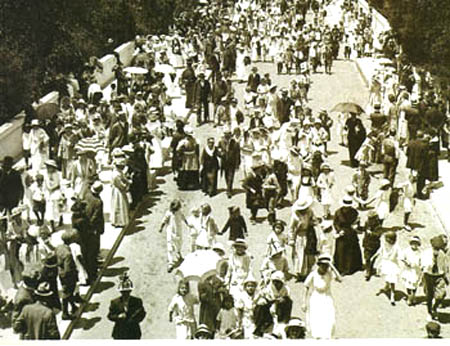
How customs have changed ... Above, people attend the exposition park in San Diego in 1915. Below, at the end of the century, people at a street fair.
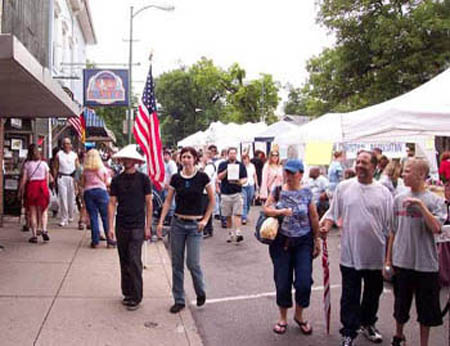 |
Most traditionalist men become indignant when they consider how, after Vatican II, a multitude of priests abandoned their cassocks and collars to adopt more “comfortable” secular clothing. This aspect of the aggioniamento of the Church with the modern world they reject absolutely. I don’t know what the young father in blue jeans and an open shirt would have thought if the priest had abandoned his cassock and collar and “opted for” more comfortable attire to wear at Mass, but I don’t think he would be pleased.
Nonetheless, for the sake of comfort and convenience, he – along with so many other traditionalist men – had abandoned his jacket, tie, and polished shoes. If he were to have an appointment to meet with the Bishop, governor or another important dignitary, he would certainly put on a suit coat and tie. Yet when he approaches the altar to receive the King of Kings in Holy Communion at the most sacral of ceremonies, the Holy Sacrifice of the Mass, he somehow finds it “enough” to don a short-sleeved shirt, casual pants or blue jeans and tennis shoes.
Clothing for men that once never would have been acceptable in the business place, at a party or even at a good restaurant, has now become commonplace at Mass, even among traditionalists. No one registers any shock to see open-neck sports shirts and other casual apparel at Mass or at the theater. What has happened here? A new component other than Vatican II has entered the picture in the last forty years. This is the triumph of the Revolution in the customs. Because I do not believe most American men would appreciate or benefit so much from a criticism based on aesthetics or fashion sense, let me try fields they are more familiar with, that is, practical considerations and the realm of principles.
Clothing has a spiritual as well as material end
Clothing, considered from a strictly practical and material point of view, one might argue, is only to cover the body. At most, the modern man might recognize its function to provide a certain sense of decency. However, those who know that man is more than mere matter also know that clothing is more than just a covering for the body. According to the natural order of things, clothing should also render a service to the soul.
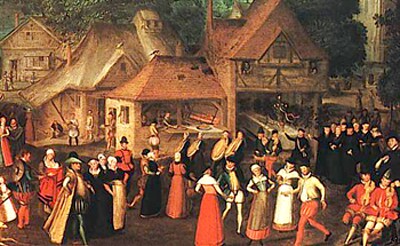
The Wedding at Bermondsey by Joris Hoefnagel, 16th c. |
As customs, manners and clothing developed under the healthy influence of the Catholic Church, it was considered a norm of common sense for clothing to complement the man’s personality, as well as his class and office in life. His attire even helped him exercise the influence necessary for his position. It was not just the Bishop and priests who wore their dignified cassocks and symbols of office, but professors, lawyers, judges, military officers, clerks, etc., assumed the clothing and honorary decorations befitting the dignity of their work.
“How elitist!” one might then exclaim.
Much to the contrary. We are not just talking about the upper class and professional men. Consider this panorama of middle-class English society in the well-known painting know as “The Wedding at Bermondsey” The painting has often been commented on for the various styles of clothing worn by the simple people of the time. The clothing ranges from elaborate dresses that were obvious imitations of upper class dress to “ordinary” working clothes and military uniforms.
However this “ordinary” clothing, as well as the bearing of the people, appear almost royal by modern standards. Each outfit expresses the varying degree of responsibility of the function that the man carries out in the close organic community. Each man reflects a sense of the dignity of his work, and also his very condition as a man, made to the image and likeness of God.
Whatever the social class, in an epoch that is concerned with elevating man, an era athirst for dignity, grandeur, and seriousness, then the apparel – common or professional – accentuates the impression of these values in each person.
The Cultural Revolution
If we understand the Revolution as the abolition of a natural and good order of things so as to replace it with a bad order of things, we can begin to analyze the Cultural Revolution that has changed the customs, habits and ways of being of modern day man. The Cultural Revolution includes a revolution in style, in which a new “loose,” “relaxed,” egalitarian and vulgar type of clothing and way of being came to replace the existing order and values that had been cultivated by Christian Civilization.
The Sorbonne Revolution of May ‘68, which found its correlation in the students’ revolt at the University of Berkeley in the U.S., was an explosion in the cultural sphere of a type of egalitarianism as radical in its own sense as Soviet Communism. The revolutionaries of May of ‘68 took over the University of the Sorbonne for some days, rebelling against all the established cultural and moral patterns. They declared themselves free of every restriction and control. “It is forbidden to forbid” was the maxim that summarized the movement. The students there created a model that would be repeated by rebellious youth in universities around the world.
These young men and women were not demanding political power, but a cultural revolution. For example, they advocated total sexual freedom, complete egalitarianism between the sexes and social classes,and the end to all inhibitions and prohibitions. As a consequence of the impact of the Sorbonne Revolution, the garb and customs of decency and propriety that demanded effort or austerity gradually disappeared - to give way to “casual” clothes and manners, which became the symbols of the hippie and punk styles.
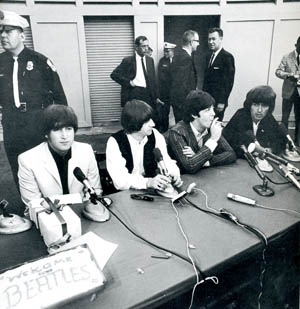
The clothing and hairstyle of the Beatles in the 1960s was considered extremely revolutionary. Today, their appearance is accepted as normal, even conservative... |
Some of those styles came to be accepted by the general public, such as the miniskirt and Bermudas, which are subtle invitations to nudism, which also was being rejected less and less every day. Earrings for men, beaded necklaces and bracelets, long hair and the consequent ponytails: these radical symbols of the revolution in style in the ‘60s, today have become commonplace on the streets and even in churches. Yes, even in the traditional circles.
These once shocking customs today are even considered mild next to the body-piercing, tattoos and other up-to-date punk styles. Some of the men who adopt these “new” styles have a clearly dirty and savage look – they are the direct heirs of the Hippie Revolution. Others, adopting many of the same customs, present themselves as clean and effeminate. The general tendency, as far as I can observe, goes and comes between these two poles.
To take one more example, an important symbol of this Revolution of the ‘60s was the now common blue jeans. Before this Cultural Revolution, jeans were common work clothes for cowboys and ranchers because of their practical durability. The ‘60s transformed the blue jean into a symbol of the egalitarian and “democratic” tendencies of the age. Faded, torn, tight-fitting, unisex, they became the uniform for the student revolutionary.
In his book, The Empire of the Ephemeral, French writer Gilles Lipovetsky reports: “The movement toward jeans anticipated the eruption of the counter-culture and the generalized spirit of contention that dominated from the end of the ‘60s.” (Paris, Gallimard, 1987, p. 95).
The Revolution of May ‘68 expressed itself more by ways of dressing, feeling, and spontaneous action and thinking than by explicit indoctrination in the theories of Marx and Freud. A consequence: today, jeans are tranquilly worn not only by the youth, but by men and women of all ages and on all occasions. That is, this symbol of the Revolution has come to be a custom, almost a tradition…
This is just one example of a subtle and profound imposition of the Cultural Revolution.
A profound transformation in clothing and way of being
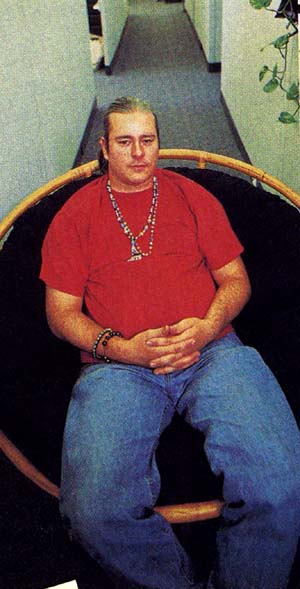
An engineer who looks like a hippy...
Time, July 3, 2000 |
Now, some 30 years after the Hippy Revolution, we can see that this egalitarian Revolution has produced profound transformations in the mentality of modern day men – even of those who call themselves conservative.
Dress began to change in a way that increasingly accentuated the idea not only of equality among sexes – with increasingly unisex clothing – but also the notion of equality among social classes. The differentiation in dress that still remained in the ‘60s to indicate a class or office of life has largely disappeared. The businessman and lawyer are removing their suits, the professor looks like the student, the doctor like his gardener.
In effect, the consequence of the underlying philosophy of this Revolution was the creation of an egalitarian, vulgar and sexually liberated culture to replace the Catholic culture characterized by harmonic inequalities and chaste customs.
To illustrate what I am saying, consider the man in the second picture and try to guess his profession. I will not hazard an opinion here for fear of denigrating any worthy occupations. In fact, he is an “in-demand” computer engineer, a professional who chose to be photographed like this for an article in Time magazine (July 3, 2000 “Is this the End.com?”, p. 44).
What mentality do these clothes and jewelry reveal? Certainly not a sense of the dignity, responsibility and elevation of spirit that one would expect from a professional man. The new “anything-goes” dress and way of being gives no opportunity for souls to mirror the moral values and notion of hierarchy necessary for good ordering of any sound society.
A restoration of customs
Many young men and women today have become admirers of Christendom and they seek its restoration, which deserves all praise. But it will not be by restoring the Latin Mass alone, combating abortion, or relearning Catholic Doctrine that Christendom will be remade. These are laudable efforts that must be made and have my entire support, but they do not comprise the whole picture.
For Christendom has always been understood as a projection of the Catholic principles into every aspect of the temporal sphere. Therefore, it becomes established to the degree that the principles of Catholic Doctrine also shape the customs and ways of being of the people. This obviously includes the clothing of a man. The more a civilization becomes Christian, the more the clothing of men will be virile, dignified, noble – from the highest dignitary to the lowest worker. They will wear dignified clothing befitting their office and station in life not only at Mass, but wherever they go. This is what one notes in the dress of former times.
Am I suggesting here that to be Catholic we have to return to the styles of the Middle Ages? Obviously not. But it is necessary for today’s man to understand and respect the principle that underlies the idea that clothing should reflect the proper diversity of situation and class that exists in all well-ordered societies, instead of unconsciously adopting the revolutionary styles of our days that stress comfort and ease.
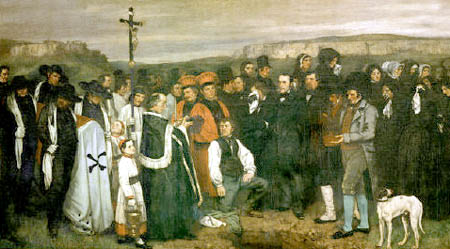
In the Funeral of Ornans by Courbet (1850), priest and parishioners dress with dignity according to their stations of life. |
It would help for a man to analyze carefully how much the Revolution in customs has infiltrated his daily ambience, and perhaps his own wardrobe and bearing, so that he can begin to counter this insidious affront to good Catholic customs. This will demand from modern man a great self-discipline, a great love of grandeur and hierarchy, a great love of seriousness, and most of all, a great love of God.
The result, as history has shown, will be well worth it. He will have the respect of his family and society, and more important, a respect for himself. He will also know that by his clothing, bearing and way of being, at all times he gives glory to God.

Posted April 18, 2006

Related Topics of Interest
 Dressing Well - Vanity or Virtue? Dressing Well - Vanity or Virtue?
 St. Isidore of Seville on the Importance of Being Dignified in Manner St. Isidore of Seville on the Importance of Being Dignified in Manner
 Four Ways to Discern a Man's Soul by His Appearance Four Ways to Discern a Man's Soul by His Appearance
 Objection: You Cannot Condemn Women Wearing Trousers Today Objection: You Cannot Condemn Women Wearing Trousers Today
 Tradition, Stagnation and Progress Tradition, Stagnation and Progress
 Courtesy in the Catholic Home Courtesy in the Catholic Home
 Language is the Dress of Thought Language is the Dress of Thought
 Questions on Fashion Questions on Fashion
 Revolution and Counter-Revolution in the Tendencies, Ideas and Facts Revolution and Counter-Revolution in the Tendencies, Ideas and Facts

Related Works of Interest
|
Manners | Cultural |
Home | Books | CDs
| Search | Contact Us
| Donate

© 2002- Tradition in Action, Inc. All Rights Reserved
|
 |

|